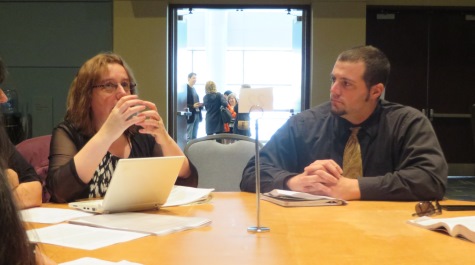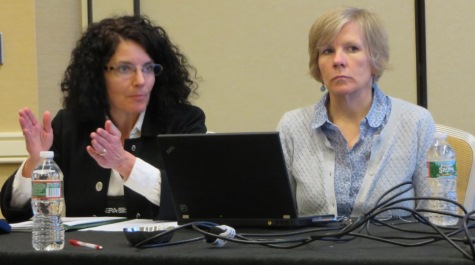American Educational Research Association Conference (AERA) 2014
William & Mary’s School of Education was well represented at the annual meeting of the American Educational Research Association (AERA) 2014 held in Philadelphia, PA. Current students and faculty as well as alumni traveled to Philadelphia to participate in research and scholarly paper presentations, roundtables, symposia, graduate student seminars, and poster sessions.
Several papers were presented by faculty and students, individually and collaboratively. Drs. Stoddard and Chen presented their paper titled, “Young People’s Views on Experts and Evidence in Political Documentaries.” Dr. Stoddard also presented a paper titled, “Teaching History with Film: The Perspectives and Pedagogies of Historians.” Dr. Jim Barber presented his paper titled, “Places and Spaces: Investigating Student Learning in Fraternity Residences.” Dr. Barber also collaborated with higher education doctoral students Leslie Bohon-Atkinson, Nancy Everson, Laura Feltman, and Sharon Stone on a paper titled, “Deep Learning and Academic Engagement.” Dr. Pamela Eddy collaborated with Washington State University’s Dr. Kelly Ward on their paper, “Leaning In or Backing Out: Questioning Career Pathways of Academic Women.” Drs. Harris and Hofer presented their paper, “’Technology, Pedagogy, and Content Knowledge (TPACK) Stories’: Schools and School Districts Repurposing a Theoretical Construct for Technology Integration Professional Development.” Finally, Dr. Eddie Cole presented his paper, “Faculty Perceptions of Senior Leaders’ Support for Teaching Innovation at Historically Black Colleges and Universities and Predominately White Institutions.”
William & Mary also made a mark in the symposium sessions with two presentations. Dr. Anne Charity-Hudley presented her symposium paper, “Tough Conversations About Language and Culture in Secondary English Classrooms” in the session, “Labovian Legacies: Symposium on Sociolinguistics and Education.” Dr. Pamela Eddy and higher education doctoral student Tehmina Khwaja presented their symposium paper, “What Happened to Revisioning Community College Leadership? A 20-Year Retrospective” in the session entitled, “Gender Issues in Community College Settings.”
School of Education faculty and students presented a number of roundtable sessions at the conference. Dr. Jeremy Stoddard collaborated with Angela Banks of the William & Mary Law School to present a roundtable paper, “The Challenges of Gaming for Democratic Education: The Case of iCivics.” Curriculum and educational technology doctoral student Kerrigan Mahoney and higher education doctoral student Tehmina Khwaja presented their collaborative research entitled, “School Leaders and Media Literacy: A Narrative Study on the Impact of Attitudes and Perceptions.” Dr. Kimberley L. Chandler presented her roundtable paper, “Innovation in Practice and Policy: Examining Curriculum Policies and Practices in Gifted Education.” Higher education doctoral student Angelo Letizia presented his research titled, “Experience of Change: Using Critical Phenomenology to Examine the Transformation of Higher Education” at a roundtable session.
Higher education doctoral student Angelo Letizia commented on his participation in the AERA 2014 conference: “Being able to present my work at one of the most prestigious education conferences in the nation is a tremendous honor. I could not have done it without the guidance of the William and Mary faculty. Attending sessions at AERA also gave me invaluable information for my dissertation.”
School of Education faculty presented two posters at the conference. Dr. Jennifer Riedl Cross, Dr. Mihyeon Kim, and Dr. Andrea Frazier of Columbus State University presented their poster, “Barriers to Achievement Among Gifted Middle School Students From High- and Low-Income Families.” Dr. Cross also collaborated with Dr. Stephen Bugaj of Lock Haven University on their poster entitled, “Finding Clues to the Stigma of Giftedness Through an Exploration of the Middle School Academic Crowd.”
Students, alumni and faculty also took advantage of the research and scholarly paper sessions, symposia, roundtable sessions, orientations, graduate student seminars, receptions and poster sessions to augment their knowledge and make connections with professors and peers from around the country and the globe. Higher education doctoral student Diana Hernandez reflected on her first AERA conference:
“As a first time attendee to the 2014 AERA Annual Meeting, the first word that comes to mind is scale. This conference is so expansive that you will need your walking shoes to get from workshop to workshop. I was told to expect this, but when you experience it for yourself, you will truly understand what I mean by scale. Leading national and international scholars are in attendance, and every educational topic you can imagine is discussed. You feel you are at the cutting edge of innovation. You see publishers speaking with scholars about their next book or scholars meeting with one another to discuss their next project(s). Buzz is the next word that comes to mind. You will feel the intellectual energy as you sit next to your scholar star in a workshop or have the opportunity to meet her/him for the first time.
“I smile as I recall seeing one of my scholar stars walking one of the very long halls of the Pennsylvania Convention Center in Philadelphia, which was the site of this year’s meeting. Having had a little practice from attending the 2013 Association for the Study of Higher Education (ASHE) conference, I had built my confidence. I called out my scholar star’s name, introduced myself, and asked if I could walk with her to discuss my interest in her work. I was ever so grateful for my walking shoes that day because she was headed in the opposite direction of my workshop. It did not matter. This was an opportunity I simply could not miss. Just this week I received an e-mail from her asking me to continue to be in touch and to reach out to her after graduation. Fellow emerging scholars, these are the moments our faculty members refer to in our classes. We are encouraged to reach out to other scholars to share our interests in their work, and this is an example of what happens when we execute the training our faculty members so generously give us. Let us all take advantage of this extraordinary education we are receiving.
“I took the advice Dr. Pam Eddy and Dr. Jamel Donnor shared. I reviewed the annual meeting’s program, selected the scholars I wanted to see, read the descriptions of the workshops in detail rather than just the title, and cross referenced dates and times to make sure I saw as many scholars as possible throughout my time at AERA. I prepared my elevator speech and my follow-up speech for those I had previously met at ASHE. I was pleasantly surprised when they remembered me. I also scheduled a one-on-one meeting with one particular scholar. I find that AERA provides a platform for emerging scholars to meet, network, and create future opportunities. I highly encourage you all to attend. You will be able to engage in conversation with leading scholars. When you meet other students from other institutions who follow our faculty members as their scholar stars, I hope you feel the same sense of pride I did when I shared that I am being trained by that particular scholar. I also hope you feel the genuine enthusiasm my peers and colleagues shared with me upon listening to my scholar stories. The School of Education at the College of William and Mary is giving me a solid educational foundation. With it, I hope to venture out to more national conferences and I hope you will too.”


